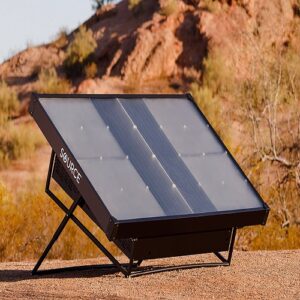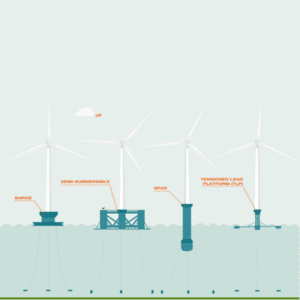The Blue Sphere, hanging around in the space along with its 7 other companions under the supervision of their father figure “The Sun”. Yes, we are talking about our home planet Earth. As seen, from the space, our Earth looks like a blue ball where, 2:1 coverage is of Water.
The Earth is a watery place. But just how much water exists on, in, and above our planet? About 71 percent of the Earth’s surface is water-covered, and the oceans hold about 96.5 percent of all Earth’s water.
The globe illustration shows blue spheres representing relative amounts of Earth’s water in comparison to the size of the Earth.
We, the residents of earth, are now-a-days moving towards the sustainable and renewable energy sources, the most of the things are related to Solar Energy only. The most common form that can be seen everywhere is Solar Power Plants.
When it comes to addressing climate change, solar energy is one of the leading solutions, and it’s here to stay. Over the years, we have witnessed a growing surge in distributed PV solar systems installed on rooftops and solar farms to increase clean energy production. After successfully utilising the vacant and unfertile lands for establishing solar farms on them, research and development have continued in this sector, we now have floating solar panels.
What are floating solar panels? These are PV modules mounted on platforms that float on water reservoirs, lakes, and where conditions are right seas and oceans. However, these solar panels floating on water are more challenging and costly to construct.
Floating solar power plant is a new and emerging concept in India. In this system the solar photo voltaic panels are installed on waterbodies such as lakes and ponds. Let’s first discuss, what are floating solar panels?
These are PV modules mounted on platforms that float on water reservoirs, lakes, and where conditions are right seas and oceans. Floating solar is also known as photovoltaics or floating photovoltaic. It refers to any solar array that floats on top of a water body. Solar panels are affixed on buoyant structures, keeping them afloat on the water body surface. These floating solar panels are mostly found on lakes and dams as they are generally calmer than oceans.
Floating solar is an eco-friendly method of producing electricity. It combines marine and renewable energy technology. The electricity is sent from this floating body through underwater cables to a transmission tower.
However, these solar panels floating on water are more challenging and costly to construct. Let’s dive in and look at this technology in detail –
A floating solar panel plant consists of the solar module, anti-rust material, vertical and horizontal frames, buoyancy body, inspection footrest, and module mount assembly. The solar module needs to be highly humidity resistant, dustproof, lead-free, and well protected from the effects of water. The buoyancy is made from polyethylene that can hold 2.5 times the weight. The floating structure is made from magnesium alloy coating, which is highly resistant to corrosion.
A floating solar panel plant consists of the solar module, anti-rust material, vertical and horizontal frames, buoyancy body, inspection footrest, and module mount assembly. The solar module needs to be highly humidity resistant, dustproof, lead-free, and well protected from the effects of water. The buoyancy is made from polyethylene that can hold 2.5 times the weight. The floating structure is made from magnesium alloy coating, which is highly resistant to corrosion.
Merits of a Floating Solar Farm-
- You Do Not Lose Valuable Land Space
Many ground-mounted solar panels result in the loss of valuable land space. However, with floating photovoltaics, you do not require land space. These installations can happen on unused space on water bodies such as wastewater treatment plants, drinking water reservoirs, or hydroelectric dam reservoirs. As a result, you can make use of land that you would have otherwise used to mount up solar panels. Additionally, installing solar panels on water bodies eliminates the need for deforestation.
- Benefits the Environment
Floating solar panels are good for the environment. Water offers a colling effect for the PV modules. However, they also reduce evaporation from these water bodies, crucial in areas susceptible to droughts.
Additionally, having the solar panels floating on the water reduces algae blooms in freshwater bodies. Algae bloom can cause health complications when they appear in drinking water sources. They can also lead to the death of animals and plants in the water bodies.
Floating solar panels generate clean energy. Using renewable energy helps reduce dependence on fossil fuels’ generated electricity. As a result, there is a reduction in greenhouse gas emissions.
- Improved Solar Performance
Though solar panels can perform well under high temperatures, their efficiency can reduce over time. As temperatures increase, their efficiency also drops. When you install PV modules on water bodies, the water provides a cooling effect which improves their efficiency.
We would like to mention some upcoming Solar Farms (Floating) that will boost the energy generation of India.
- At Omkareshwar Reservoir (600 MW) in the state of Madhya Pradesh
- At Ramagundam Reservoir (100 MW) in the state of Telangana
- Kayamkulam project (92 MW) at Kerala
- Getalsud Dam Project (100MW) at Jharkhand
- Rihand Dam (50 MW) at Uttar Pradesh
References:
https://www.saurenergy.com/solar-energy-blog/the-top-5-upcoming-floating-solar-power-projects-in-india
https://www.dynamicslr.com/floating-solar-panels/
https://www.cseindia.org/floating-solar-power-plant-interview-with-vivek-jha-8031





